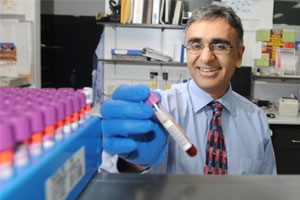
QUEENSLAND researchers have made a breakthrough in the treatment of Hodgkin’s lymphoma, finding a way to minimise the amount of chemotherapy patients have to endure to fight the cancer.
Queensland research into Hodgkin’s lymphoma has discovered a way to help individualise cancer treatment for each patient, with potential to improve survival and prevent side-effects for a range of cancers.
For the first time, PA Hospital’s Professor Maher Gandhi and researchers at the Translational Research Institute and the Cancer Council have identified molecules, called ‘microRNA’ within the blood that mirror a patient’s response to treatment.
The groundbreaking research, published in Clinical Cancer Research, could lead to better management and tailored therapy for those diagnosed with Hodgkin’s lymphoma, and potentially other cancers.
Other investigators are using the same approach to determine individualised breast and prostate cancer treatment.
Professor Maher Gandhi said a major issue with a diagnosis of Hodgkin’s Lymphoma was developing individual therapy to ensure each patient received the best treatment for their disease.
“On the one hand, it is important that patients with rapidly responding disease are not over treated, as this will mean they suffer unnecessary side-effects of treatment,” Professor Gandhi said.
“But on the other hand, those with poorly responding Hodgkin’s lymphoma need to be identified early, so that they can be switched to other treatments early on, during the course of their illness.”
Cancer Council Queensland spokesperson Katie Clift said identifying appropriate treatment for patients with Hodgkin’s lymphoma was crucial.
“This world-leading research will allow clinicians to continue making inroads in individualised cancer treatment, further improving patients’ prospects for longer-term survival,” Ms Clift said.
“About 120 Queenslanders are diagnosed with Hodgkin’s lymphoma each year, and about 20 die from the disease.
“Five-year relative survival from Hodgkin’s Lymphoma has increased from just 72 per cent in the 1980s to 87 per cent today, a trend we hope to see continue with thanks to this breakthrough.”
Hodgkin’s lymphoma is a cancer of the lymphatic system, with largely unknown causes.
The most common first symptom of Hodgkin’s lymphoma is a painless swollen lymph gland in your neck, underarm, or groin. Other symptoms may include unexplained fevers, night sweats, weight loss and tiredness.
More information about Cancer Council Queensland is available via Cancer Council Helpline 13 11 20 or cancerqld.org.au.
http://www.health.qld.gov.au/metrosouth/news/140721-hodgkins-breakthrough.asp
